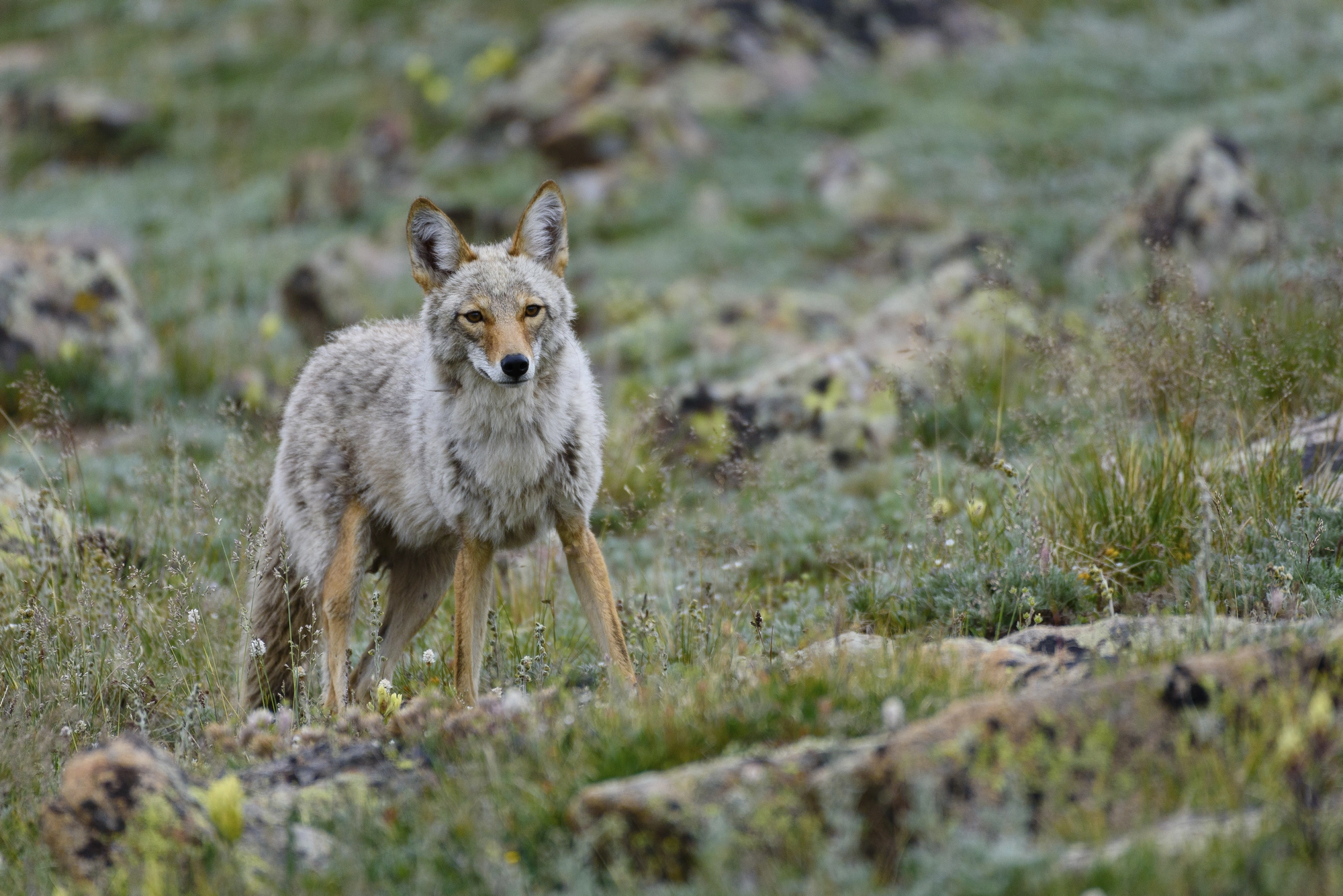In 2018, I took a trip — cameras in hand — to Rocky Mountain National Park with a good friend who was trying to help me get back on track after a traumatic experience that had left me in a deep state of depression. She suggested we take a road trip to clear my head and help me find a little sanity, so we headed out to Estes Park and into the RMNP.
After driving up the mountain to the top of the peaks overlooking the valley floor, my friend caught movement out of the corner of her eye as we were driving. She asked me to pull off to the side of the road into a turnout so she could get a better look. To her — and my surprise — it was a coyote in a white coat.
Not knowing what to think, as I had never seen a coyote in an alpine meadow before, we got out of the RV she had jokingly named Sonny and grabbed our cameras. Both of us had long lenses and focused on this amazing canine from about two hundred feet away. The coyote turned toward us as it searched among rocks and boulders in the willows. As it approached, we put some distance between us and it by edging closer to the RV, ready to dash back inside if needed.
From there, we made a series of images as the coyote went about its mission, hunting what we could only presume were marmots, ground squirrels, or possibly anything it could find to ease its hunger. We stayed a while, watching as the coyote moved through the willows until it disappeared behind some rocks and headed downhill, following the road back to the valley floor.
It was then that I knew I needed to learn more about coyotes — animals I had only ever associated with open prairie and wooded areas of the northern and southern plains. What I found was fascinating and led me to a much deeper understanding of their habits in the rugged high country of the Rocky Mountains — from the snow-crusted drainages to wind-scoured alpine basins. The coyote (Canis latrans) is at home here, from subalpine forests to alpine meadows and ridgelines above 7,000 feet. Though smaller than wolves, coyotes’ adaptability makes them one of the most successful carnivores in North America.
With wolves largely absent from many parts of the Rockies, coyotes have stepped into a mid-level predator niche. Their size—typically 20 to 50 pounds—and wide dietary breadth let them exploit prey and conditions other predators might bypass. But surviving at elevation demands more than just flexibility. It requires mastery of snow, rock, cold, and scarce prey.
Range & Habitat: From Valley to Alpine
Coyotes evolved in open plains and grasslands, but over time they’ve colonized virtually every habitat from deserts to tundra. In the Rockies, their vertical range is impressive: they use montane zones, subalpine forests, forest edges, and even above the treeline in alpine basins.
They favor ecotones—edges between forest and open meadows, willow thickets along creeks, avalanche chutes, and stunted spruce or fir patches. These transitional zones offer both cover and access to prey. Higher up, they patrol ridgelines, rock slides, or tundra meadows, especially where pockets of prey like pikas and marmots persist. Snowpack, wind scour, and exposure determine how far above tree line they’ll venture in winter. Because prey is sparse at high elevation, coyote territories here tend to be large and irregular.
Territory & Social Structure
Coyotes are often portrayed as solitary, but in truth their social life is flexible. In high country they tend to exist in pairs or small family groups. Packs of four or five may form where prey is abundant or habitat structure allows.
In rugged terrain, a single coyote’s home range — the area it uses for hunting, resting, and denning — can span 8–15 square miles or more. Because prey is scattered, coyotes often need to roam widely. Overlap between neighboring ranges is common, especially in times of resource abundance. They mark boundaries with scent, scat, and howls, but aggressive territorial defense peaks during breeding and pup-rearing season.
In alpine and subalpine terrain, coyotes typically choose den sites on south- or southwest-facing slopes where sun keeps the ground warmer and drier. Dens may be dug into hillsides, tucked under talus, or expanded from old badger or fox burrows. The key is good drainage and multiple escape routes.
Late spring marks pupping season. Litters usually number four to seven pups, though survival depends on food, weather, and predation risk. During this time, adults narrow their daily range and focus hunting closer to the den.
Diet: Generalist Predator in a Harsh World
Coyotes are opportunists. Their diet in high elevation areas is shaped by what survives there: small mammals, seasonal birds, insects, and carrion.
Primary Prey
- Rodents & Lagomorphs: Pikas, marmots, ground squirrels, chipmunks, and voles form the core diet.
- Rabbits: Mountain cottontails and snowshoe hares supplement food stores.
- Neonatal Ungulates: In summer, coyotes may prey on mule deer fawns or elk calves, especially when cover and timing favor ambush.
- Carrion & Scavenging: In winter or after die-offs, they readily feed on deer, elk, and even livestock carcasses.
- Invertebrates & Vegetation: During summer, grasshoppers, crickets, berries, and other fruits pad lean periods.
Small mammals make up most meals by number, but a single ungulate carcass can sustain a family for days. In deep winter, carrion becomes a vital lifeline when rodents go quiet under snow.

Habits & Behavior: Surviving the Extremes
Daily Activity & Movement
Coyotes are mostly active at dawn and dusk, though their schedule changes with human presence and prey. In remote alpine basins they may hunt in broad daylight. They travel efficiently, following wind-scoured ridges, hardened snow crusts, or ungulate trails to conserve energy. Deep snow often forces them to lower elevations or stick to sheltered corridors.
Hunting Tactics
Most hunts are solo or by pairs, but small groups may form when tackling larger prey. Coyotes stalk and ambush rather than run down animals over long distances. For rodents and pikas they use a silent approach and quick pounce; for larger prey they look for vulnerable fawns or injured adults.
Communication & Vocalization
Howls, yips, and barks advertise territory, keep family groups connected, and warn rivals. In mountain basins, their calls echo far across ridges at night. Scent marking and scat also keep boundaries clear.
Seasonal and Elevational Movement
- Winter: Many drop into valleys and foothills where snow is shallower and prey is easier to catch. Some remain higher if windblown ridges and carrion are available.
- Spring/Summer: As snow melts and rodents emerge, coyotes push back up. This is denning season.
- Fall: They roam widely following rodent booms, ungulate migrations, and other food pulses.
Ecological Role: More Than A Just Predator
Coyotes are key players in alpine and subalpine ecosystems. By hunting small mammals like pikas, marmots, and voles, they help regulate populations and prevent overgrazing of delicate alpine meadows. Their scavenging cleans up carcasses, recycling nutrients and limiting disease spread.
In the absence of wolves across much of the Rockies, coyotes act as top canids in many zones. They influence deer fawn survival, compete with foxes and bobcats, and indirectly affect herbivore movement and vegetation patterns. Where wolves or mountain lions return, coyotes often adapt by avoiding prime predator habitat or shifting activity to new niches.

High-Country Challenges & Adaptations
Life above 7,000 feet isn’t easy:
- Cold & Snow: Deep snow and long winters make travel and hunting difficult. Coyotes mitigate this by using wind-scoured slopes, ridges, and compacted trails.
- Low Prey Density: Scarcity forces wide ranging and opportunistic feeding.
- Exposure & Energetics: Thin air, harsh wind, and UV demand efficient energy use and smart den selection.
- Seasonal Bottlenecks: Late winter and early spring can starve adults and limit pup survival.
- Human Encroachment: Backcountry cabins, ski areas, and food waste can attract coyotes and cause problematic habituation.
Observing Coyotes: Field Notes from the Ridge
For photographers and wildlife watchers, spotting a mountain coyote is about patience and awareness:
- Scan ridges, meadows, and creek edges at dawn or dusk.
- Listen for distant howls in evening quiet.
- Look for tracks in wind-packed snow or fresh mud.
- Glass talus slopes and alpine meadows where pikas and marmots live.
- Avoid disturbing dens in late spring—adults may defend pups.
Coyotes in the Rocky Mountains embody adaptability. They roam vast territories, shift diets with the seasons, and survive in some of the harshest conditions in North America. They are quiet architects of alpine ecosystems—controlling small mammal numbers, cleaning carrion, and shaping how other animals use the land.
For hikers and photographers, a glimpse of one moving across a ridgeline or weaving through willow thickets is a reminder: even in windswept tundra, life persists, clever and resilient. The alpine coyote may not have the fame of wolves or mountain lions, but its survival story is one of grit and wild intelligence.
References and research
- National Park Service – Coyotes in Rocky Mountain National Park
- USDA Forest Service – Fire Effects Information System: Coyote
- USDA APHIS – Coyotes: Wildlife Damage Management Technical Series
- NPS Fauna Series – The Coyote
- Montana Field Guide – Coyote
- Wikipedia – Rocky Mountain National Park (Wildlife)
- Wikipedia – Mountain Cottontail
- WellBeing International Studies Repository – Coyote Ecology & Behavior
- ResearchGate – Coyote Home Range and Movements






